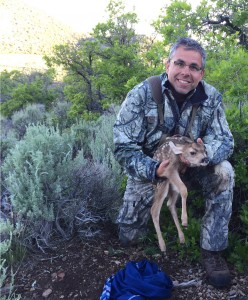
BYU students may continue to have interesting and sometimes intimidating encounters with deer on campus as Utah’s deer population increases.
Brock McMillan, the department chair of Plant and Wildlife Sciences, said mild winters have contributed to the increase in the deer population.
“We’ve had four or five mild winters in a row, and winter is when we usually have the greatest mortality rates,” McMillan said. “We’ve had very high survival, so deer numbers are very high in the state right now.”
He said students should not harass the deer on campus, and should act normally around the deer. He said deer can be dangerous if they feel threatened or cornered.
McMillan said he normally doesn’t have a problem with the deer being on campus, with exceptions for when they consume ornamental plants and become in danger of being hit by traffic.
Steven Petersen, a plant and wildlife sciences professor at BYU, said the deer are attracted to campus because there is good hiding cover and easier access to plants and food sources than is available in the mountains.
Petersen said students are most likely to encounter deer on Temple Hill and above the trail that connects the Life Science Building and the Smith Fieldhouse. He also advised students to be respectful during encounters with deer around campus and not feed or chase them.
“Urbanization has fragmented (the deers’) habitats,” said Stephanie Jochum-Natt, founder of the Wild Aware Utah program which trains people how to handle wildlife encounters. “In the spring, the deer need to migrate back up the mountain, but they have a hard time crossing roads, and getting around buildings. People need to pay attention to what’s keeping the deer in their neighborhoods, like compost piles or gardens.”
Jochum-Natt said feeding the deer will cause them to stay and reproduce rather than return to their spring habitat. Their offspring will not know how to migrate back into the mountains, and generations of deer may get trapped in an area dangerous to them because of traffic and other hazards associated with people.
Jochum-Natt also emphasized that feeding the deer is not good for them because their stomachs can’t digest food properly.
“The deer can starve to death with a full stomach. They can’t even benefit from the food people give them. Everyone needs to encourage each other not to feed the deer,” Jochum-Natt said.
Students wanting to better understand proper interactions with deer and other wildlife can visit Wild Aware Utah’s website to find more information.




